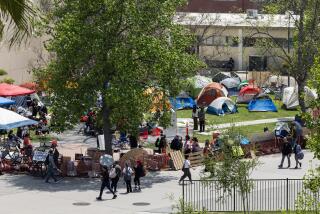Plan to Expand Ports Meets With Public Criticism : Harbor area: About 150 people, most voicing opposition, crowded a hearing about $4.8-billion expansion of L.A. and Long Beach ports by 2020.
Harbor-area residents packed a public hearing this week to strongly criticize the proposed $4.8-billion expansion of Los Angeles and Long Beach harbors, fearing the project’s environmental consequences would outweigh its economic benefits.
But the community concerns over air quality, traffic, marine life and other issues were not shared by local politicians and port businesses, who touted the so-called 2020 project as a model to accommodate the inevitable growth of the harbors--already the nation’s busiest.
In the first and only hearing on the project’s massive environmental report, about 150 people met Tuesday night at the Los Angeles Harbor Department’s headquarters in San Pedro. And although the two dozen speakers addressing the report were almost evenly split among supporters and opponents of the project, the standing-room-only crowd was clearly behind the project’s opponents, interrupting several times with applause.
“I understand the necessity for growth and development but we are doing it here for reasons that don’t make any sense to me or my quality of life,” said Larry Roteman, an electrical contractor from San Pedro.
Added Tony Kay of the Wilmington Home Owners: “The conclusion seems to be (that) if it is economically beneficial for the ports, to hell with local communities.”
The two-hour hearing was aimed at garnering public input on the project’s recently released 8,000-page environmental report--a study that details how the harbors would be dredged for shipping and to provide landfill to expand Terminal Island. The hearing was conducted by the U.S. Army Corps of Engineers, which is expected to recommend that the federal government contribute $141 million to the project.
The environmental report, prepared by the ports and the corps of engineers, focuses on the project’s first phase, a $3.5-billion undertaking that would add 1,444 acres of landfill to Terminal Island and dredge the harbors for deeper channels. That work, the report concludes, would aggravate already poor air quality in the region, disrupt marine life in the harbors and adversely affect commercial fishing and public recreation.
At the same time, the report argues that the explosive growth in the ports’ business demands some expansion of facilities. Otherwise, the report says, even-greater environmental problems could occur as the harbor becomes too crowded for shipping, forcing trains and trucks to carry the goods demanded by Southern California’s ever-growing population and commerce.
The impacts “do not appear to outweigh the benefits of the project to the nation and the region,” Col. Charles S. Thomas, the corps’ district engineer, told the crowd Tuesday night in reviewing the environmental report.
The project and the report’s findings were applauded by area politicians--including Los Angeles Mayor Tom Bradley and Rep. Glenn M. Anderson (D-San Pedro)--as well as corporations doing business in the ports.
Given the inevitability of growth in the harbors and the 2020 project’s plans for meeting that growth, Richard Holdaway, president of Kaiser International Corp. told the hearing: “I can’t believe anybody who lives in San Pedro would oppose this project.”
He was wrong.
“I hate to see the loss of 1,600 acres” of recreational waterways, said Martin Hochman of San Pedro, referring to the harbor waters that will be taken over by landfill and commercial ships. “The loss of that cannot be mitigated,” Hochman said.
Bob Seaborne, who heads the Fisherman’s Cooperative Assn. in San Pedro, said he was afraid that expansion of the ports would accommodate cargo ships at the expense of commercial fishing.
And Ken Malloy, a Los Angeles city environmental commissioner, voiced concern that the project would destroy the foraging and breeding areas of the endangered California least tern.
“I’ve seen the least tern come and go, mostly go,” Malloy said, skeptical that the ports will successfully relocate the species to new habitats. “You just can’t say to a tern, ‘You are moving over here,’ ” Malloy said.
Port clients and elected officials, however, countered that the 2020 project was a vital and adequately studied solution to nearly 20 years of federal and local discussion of expanding the ports.
“The further growth of the Port of Los Angeles is vital to the continued dynamics of international trade between this country and others worldwide,” Mayor Bradley said in a letter read at the hearing. “Certainly the demands for diversified goods and services by the Los Angeles area’s 14 million residents today, as well as similar needs for an estimated 18 million by the year 2020, dictate that the port must prepare now for the next 30 years.”
Similarly, Rep. Anderson offered a prepared statement on the project that praised it as one that holds “enormous” economic importance for the region and the country. Today, he noted, the ports’ trade and shipbuilding account for about 250,000 jobs in the region and contribute an estimated $25 billion to the area’s economy.
“I am keenly aware of environmental, transportation and other related problems that are associated with this project,” Anderson said. “I am confident that all parties can continue to work together to mitigate these concerns prior to completion of the project.”
After the hearing, officials with the ports and the corps of engineers said they expect most of the environmental consequences of the ports’ expansion to be minimized through the use of new technologies and other projects related to the 2020 plan. Those other projects include a new rail and truck corridor between the ports and downtown Los Angeles that would ease traffic elsewhere in the harbor area.
Further, officials argued that the 2020 project would improve safety in the ports and surrounding communities. The deeper channels, they said, would more safely accommodate today’s larger vessels. And the expansion of Terminal Island, they added, would allow the relocation of hazardous fuel tanks now near Wilmington’s residential neighborhoods.
Not all of the project’s impacts could be offset, however. The loss of some recreational areas within the harbor, for example, would have an unavoidable impact on area residents, officials said.
But overall, they argued, the 2020 project would provide the ports with the new land and terminals they need with minimal disruption to the coastline.
The environmental report will now be revised, with Tuesday’s comments, for presentation to the federal government. Meanwhile, the project faces a series of reviews by state and local agencies, including the California Coastal Commission and the South Coast Air Quality Management District.
More to Read
Start your day right
Sign up for Essential California for news, features and recommendations from the L.A. Times and beyond in your inbox six days a week.
You may occasionally receive promotional content from the Los Angeles Times.






